Yong Xia
ECG-aBcDe: Overcoming Model Dependence, Encoding ECG into a Universal Language for Any LLM
Sep 16, 2025Abstract:Large Language Models (LLMs) hold significant promise for electrocardiogram (ECG) analysis, yet challenges remain regarding transferability, time-scale information learning, and interpretability. Current methods suffer from model-specific ECG encoders, hindering transfer across LLMs. Furthermore, LLMs struggle to capture crucial time-scale information inherent in ECGs due to Transformer limitations. And their black-box nature limits clinical adoption. To address these limitations, we introduce ECG-aBcDe, a novel ECG encoding method that transforms ECG signals into a universal ECG language readily interpretable by any LLM. By constructing a hybrid dataset of ECG language and natural language, ECG-aBcDe enables direct fine-tuning of pre-trained LLMs without architectural modifications, achieving "construct once, use anywhere" capability. Moreover, the bidirectional convertibility between ECG and ECG language of ECG-aBcDe allows for extracting attention heatmaps from ECG signals, significantly enhancing interpretability. Finally, ECG-aBcDe explicitly represents time-scale information, mitigating Transformer limitations. This work presents a new paradigm for integrating ECG analysis with LLMs. Compared with existing methods, our method achieves competitive performance on ROUGE-L and METEOR. Notably, it delivers significant improvements in the BLEU-4, with improvements of 2.8 times and 3.9 times in in-dataset and cross-dataset evaluations, respectively, reaching scores of 42.58 and 30.76. These results provide strong evidence for the feasibility of the new paradigm.
Unified Start, Personalized End: Progressive Pruning for Efficient 3D Medical Image Segmentation
Sep 11, 2025Abstract:3D medical image segmentation often faces heavy resource and time consumption, limiting its scalability and rapid deployment in clinical environments. Existing efficient segmentation models are typically static and manually designed prior to training, which restricts their adaptability across diverse tasks and makes it difficult to balance performance with resource efficiency. In this paper, we propose PSP-Seg, a progressive pruning framework that enables dynamic and efficient 3D segmentation. PSP-Seg begins with a redundant model and iteratively prunes redundant modules through a combination of block-wise pruning and a functional decoupling loss. We evaluate PSP-Seg on five public datasets, benchmarking it against seven state-of-the-art models and six efficient segmentation models. Results demonstrate that the lightweight variant, PSP-Seg-S, achieves performance on par with nnU-Net while reducing GPU memory usage by 42-45%, training time by 29-48%, and parameter number by 83-87% across all datasets. These findings underscore PSP-Seg's potential as a cost-effective yet high-performing alternative for widespread clinical application.
Toward Robust Medical Fairness: Debiased Dual-Modal Alignment via Text-Guided Attribute-Disentangled Prompt Learning for Vision-Language Models
Aug 26, 2025
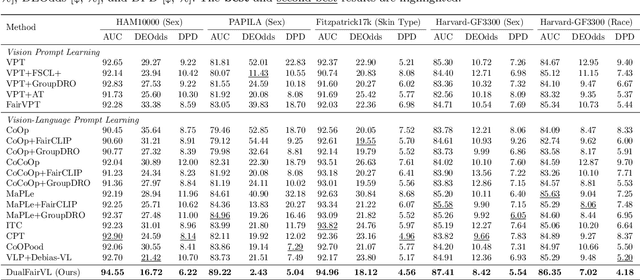
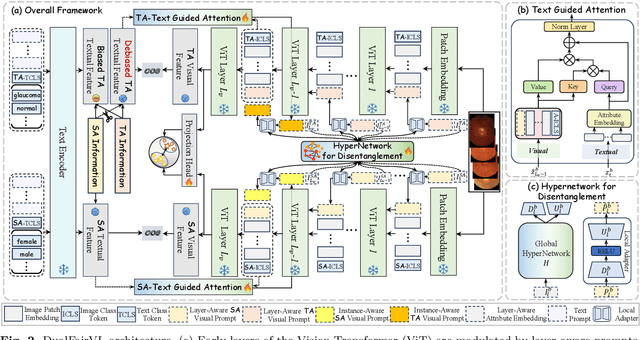
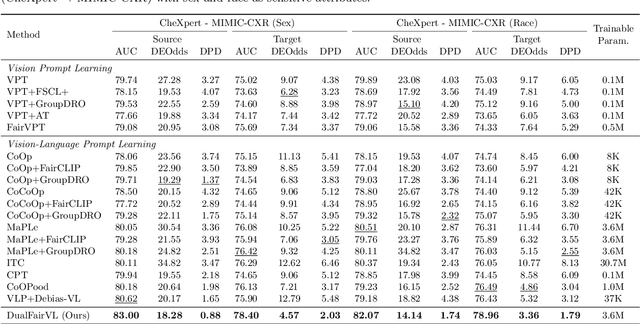
Abstract:Ensuring fairness across demographic groups in medical diagnosis is essential for equitable healthcare, particularly under distribution shifts caused by variations in imaging equipment and clinical practice. Vision-language models (VLMs) exhibit strong generalization, and text prompts encode identity attributes, enabling explicit identification and removal of sensitive directions. However, existing debiasing approaches typically address vision and text modalities independently, leaving residual cross-modal misalignment and fairness gaps. To address this challenge, we propose DualFairVL, a multimodal prompt-learning framework that jointly debiases and aligns cross-modal representations. DualFairVL employs a parallel dual-branch architecture that separates sensitive and target attributes, enabling disentangled yet aligned representations across modalities. Approximately orthogonal text anchors are constructed via linear projections, guiding cross-attention mechanisms to produce fused features. A hypernetwork further disentangles attribute-related information and generates instance-aware visual prompts, which encode dual-modal cues for fairness and robustness. Prototype-based regularization is applied in the visual branch to enforce separation of sensitive features and strengthen alignment with textual anchors. Extensive experiments on eight medical imaging datasets across four modalities show that DualFairVL achieves state-of-the-art fairness and accuracy under both in- and out-of-distribution settings, outperforming full fine-tuning and parameter-efficient baselines with only 3.6M trainable parameters. Code will be released upon publication.
Deformable Medical Image Registration with Effective Anatomical Structure Representation and Divide-and-Conquer Network
Jun 24, 2025Abstract:Effective representation of Regions of Interest (ROI) and independent alignment of these ROIs can significantly enhance the performance of deformable medical image registration (DMIR). However, current learning-based DMIR methods have limitations. Unsupervised techniques disregard ROI representation and proceed directly with aligning pairs of images, while weakly-supervised methods heavily depend on label constraints to facilitate registration. To address these issues, we introduce a novel ROI-based registration approach named EASR-DCN. Our method represents medical images through effective ROIs and achieves independent alignment of these ROIs without requiring labels. Specifically, we first used a Gaussian mixture model for intensity analysis to represent images using multiple effective ROIs with distinct intensities. Furthermore, we propose a novel Divide-and-Conquer Network (DCN) to process these ROIs through separate channels to learn feature alignments for each ROI. The resultant correspondences are seamlessly integrated to generate a comprehensive displacement vector field. Extensive experiments were performed on three MRI and one CT datasets to showcase the superior accuracy and deformation reduction efficacy of our EASR-DCN. Compared to VoxelMorph, our EASR-DCN achieved improvements of 10.31\% in the Dice score for brain MRI, 13.01\% for cardiac MRI, and 5.75\% for hippocampus MRI, highlighting its promising potential for clinical applications. The code for this work will be released upon acceptance of the paper.
Enjoying Information Dividend: Gaze Track-based Medical Weakly Supervised Segmentation
May 28, 2025Abstract:Weakly supervised semantic segmentation (WSSS) in medical imaging struggles with effectively using sparse annotations. One promising direction for WSSS leverages gaze annotations, captured via eye trackers that record regions of interest during diagnostic procedures. However, existing gaze-based methods, such as GazeMedSeg, do not fully exploit the rich information embedded in gaze data. In this paper, we propose GradTrack, a framework that utilizes physicians' gaze track, including fixation points, durations, and temporal order, to enhance WSSS performance. GradTrack comprises two key components: Gaze Track Map Generation and Track Attention, which collaboratively enable progressive feature refinement through multi-level gaze supervision during the decoding process. Experiments on the Kvasir-SEG and NCI-ISBI datasets demonstrate that GradTrack consistently outperforms existing gaze-based methods, achieving Dice score improvements of 3.21\% and 2.61\%, respectively. Moreover, GradTrack significantly narrows the performance gap with fully supervised models such as nnUNet.
SPP-SBL: Space-Power Prior Sparse Bayesian Learning for Block Sparse Recovery
May 13, 2025Abstract:The recovery of block-sparse signals with unknown structural patterns remains a fundamental challenge in structured sparse signal reconstruction. By proposing a variance transformation framework, this paper unifies existing pattern-based block sparse Bayesian learning methods, and introduces a novel space power prior based on undirected graph models to adaptively capture the unknown patterns of block-sparse signals. By combining the EM algorithm with high-order equation root-solving, we develop a new structured sparse Bayesian learning method, SPP-SBL, which effectively addresses the open problem of space coupling parameter estimation in pattern-based methods. We further demonstrate that learning the relative values of space coupling parameters is key to capturing unknown block-sparse patterns and improving recovery accuracy. Experiments validate that SPP-SBL successfully recovers various challenging structured sparse signals (e.g., chain-structured signals and multi-pattern sparse signals) and real-world multi-modal structured sparse signals (images, audio), showing significant advantages in recovery accuracy across multiple metrics.
Vision-Amplified Semantic Entropy for Hallucination Detection in Medical Visual Question Answering
Mar 26, 2025Abstract:Multimodal large language models (MLLMs) have demonstrated significant potential in medical Visual Question Answering (VQA). Yet, they remain prone to hallucinations-incorrect responses that contradict input images, posing substantial risks in clinical decision-making. Detecting these hallucinations is essential for establishing trust in MLLMs among clinicians and patients, thereby enabling their real-world adoption. Current hallucination detection methods, especially semantic entropy (SE), have demonstrated promising hallucination detection capacity for LLMs. However, adapting SE to medical MLLMs by incorporating visual perturbations presents a dilemma. Weak perturbations preserve image content and ensure clinical validity, but may be overlooked by medical MLLMs, which tend to over rely on language priors. In contrast, strong perturbations can distort essential diagnostic features, compromising clinical interpretation. To address this issue, we propose Vision Amplified Semantic Entropy (VASE), which incorporates weak image transformations and amplifies the impact of visual input, to improve hallucination detection in medical VQA. We first estimate the semantic predictive distribution under weak visual transformations to preserve clinical validity, and then amplify visual influence by contrasting this distribution with that derived from a distorted image. The entropy of the resulting distribution is estimated as VASE. Experiments on two medical open-ended VQA datasets demonstrate that VASE consistently outperforms existing hallucination detection methods.
Stealthy Patch-Wise Backdoor Attack in 3D Point Cloud via Curvature Awareness
Mar 12, 2025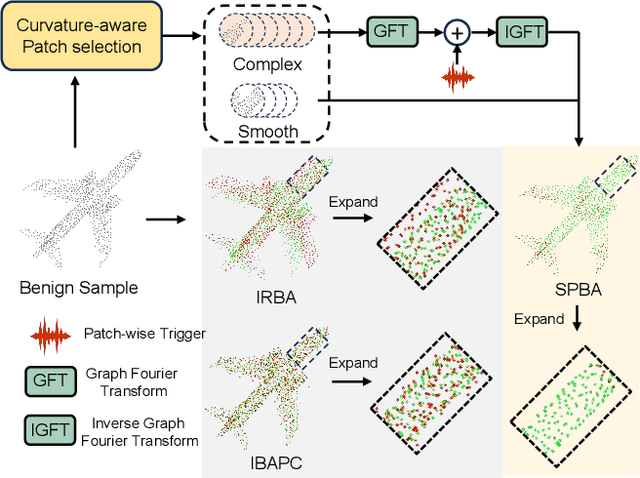

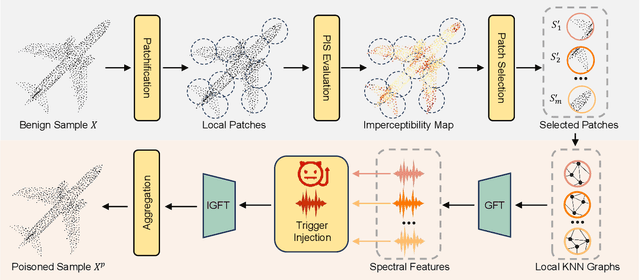

Abstract:Backdoor attacks pose a severe threat to deep neural networks (DNN) by implanting hidden backdoors that can be activated with predefined triggers to manipulate model behaviors maliciously. Existing 3D point cloud backdoor attacks primarily rely on sample-wise global modifications, resulting in suboptimal stealthiness. To address this limitation, we propose Stealthy Patch-Wise Backdoor Attack (SPBA), which employs the first patch-wise trigger for 3D point clouds and restricts perturbations to local regions, significantly enhancing stealthiness. Specifically, SPBA decomposes point clouds into local patches and evaluates their geometric complexity using a curvature-based patch imperceptibility score, ensuring that the trigger remains less perceptible to the human eye by strategically applying it across multiple geometrically complex patches with lower visual sensitivity. By leveraging the Graph Fourier Transform (GFT), SPBA optimizes a patch-wise spectral trigger that perturbs the spectral features of selected patches, enhancing attack effectiveness while preserving the global geometric structure of the point cloud. Extensive experiments on ModelNet40 and ShapeNetPart demonstrate that SPBA consistently achieves an attack success rate (ASR) exceeding 96.5% across different models while achieving state-of-the-art imperceptibility compared to existing backdoor attack methods.
Meta Curvature-Aware Minimization for Domain Generalization
Dec 16, 2024Abstract:Domain generalization (DG) aims to enhance the ability of models trained on source domains to generalize effectively to unseen domains. Recently, Sharpness-Aware Minimization (SAM) has shown promise in this area by reducing the sharpness of the loss landscape to obtain more generalized models. However, SAM and its variants sometimes fail to guide the model toward a flat minimum, and their training processes exhibit limitations, hindering further improvements in model generalization. In this paper, we first propose an improved model training process aimed at encouraging the model to converge to a flat minima. To achieve this, we design a curvature metric that has a minimal effect when the model is far from convergence but becomes increasingly influential in indicating the curvature of the minima as the model approaches a local minimum. Then we derive a novel algorithm from this metric, called Meta Curvature-Aware Minimization (MeCAM), to minimize the curvature around the local minima. Specifically, the optimization objective of MeCAM simultaneously minimizes the regular training loss, the surrogate gap of SAM, and the surrogate gap of meta-learning. We provide theoretical analysis on MeCAM's generalization error and convergence rate, and demonstrate its superiority over existing DG methods through extensive experiments on five benchmark DG datasets, including PACS, VLCS, OfficeHome, TerraIncognita, and DomainNet. Code will be available on GitHub.
Breaking the Cycle of Recurring Failures: Applying Generative AI to Root Cause Analysis in Legacy Banking Systems
Nov 20, 2024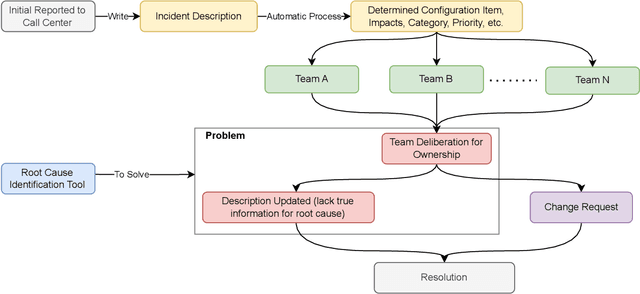

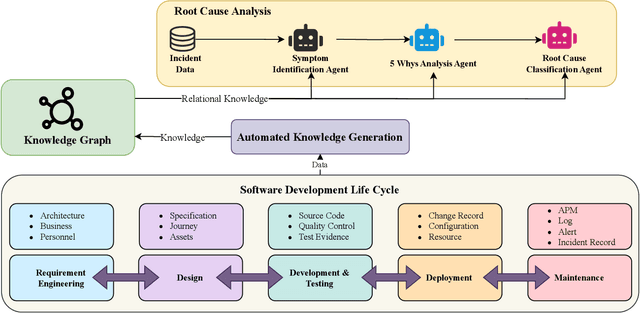

Abstract:Traditional banks face significant challenges in digital transformation, primarily due to legacy system constraints and fragmented ownership. Recent incidents show that such fragmentation often results in superficial incident resolutions, leaving root causes unaddressed and causing recurring failures. We introduce a novel approach to post-incident analysis, integrating knowledge-based GenAI agents with the "Five Whys" technique to examine problem descriptions and change request data. This method uncovered that approximately 70% of the incidents previously attributed to management or vendor failures were due to underlying internal code issues. We present a case study to show the impact of our method. By scanning over 5,000 projects, we identified over 400 files with a similar root cause. Overall, we leverage the knowledge-based agents to automate and elevate root cause analysis, transforming it into a more proactive process. These agents can be applied across other phases of the software development lifecycle, further improving development processes.
 Add to Chrome
Add to Chrome Add to Firefox
Add to Firefox Add to Edge
Add to Edge